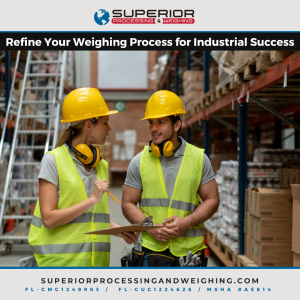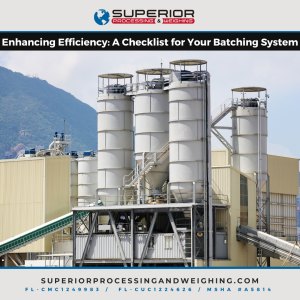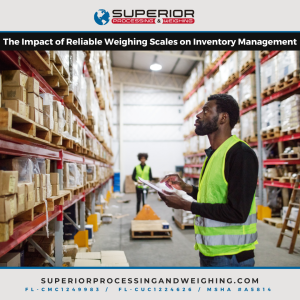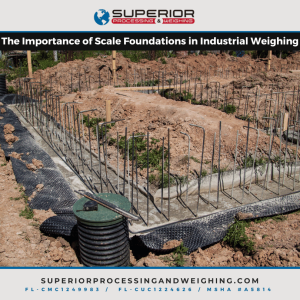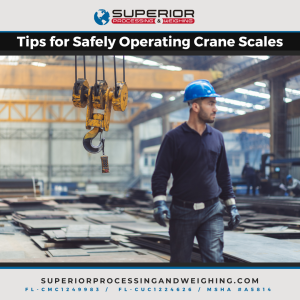Calibration is pivotal in the realm of industrial weighing, ensuring accuracy across various applications in manufacturing, recycling, and automobile sectors. At Superior Processing and Weighing, we recognize the crucial role that calibration plays in maintaining precise measurements, which is why we offer a comprehensive range of industrial scale calibration services. This article aims to elucidate the differences between internal and external calibration methods and guide you through best practices for maintaining the accuracy of your industrial scales.
Understanding Calibration: The Bedrock of Accurate Weighing
Calibration is the meticulous process of validating and adjusting the measurement accuracy of weighing equipment. It ensures that our industrial scales provide precise readings, which form the backbone of operational efficiency. Regular calibration is not merely a recommendation; it is an indispensable practice that guarantees our weighing systems deliver consistent and reliable results. Inaccurate measurements can lead to significant financial losses and pose safety risks, thus emphasizing the importance of regular scale calibration.
Internal Calibration: An Efficient Yet Limited Solution
Internal calibration involves the scale’s built-in systems automatically adjusting its readings based on predefined standards. Many modern industrial weighing systems come equipped with automated internal calibration features, designed to maintain accuracy with minimal manual intervention.
Advantages of Internal Calibration
1. Efficiency: Internal calibration is often faster than external methods, given that it can frequently be performed on-site without requiring specialized personnel.
2. Convenience: Built-in systems facilitate regular checks, reducing downtime and ensuring that the scales remain operational.
3. Consistency: Automated internal calibration provides consistent results, which is vital for precision weighing in various industrial processes.
However, internal calibration methods have their limitations. Automated systems might not account for external factors such as environmental changes or wear and tear. Consequently, relying solely on internal calibration could lead to potential inaccuracies over time.
External Calibration: A Thorough and Reliable Approach
Conversely, external calibration involves a more hands-on methodology. This process typically requires trained professionals who use calibrated weights to adjust and verify the accuracy of industrial scales. At Superior Processing and Weighing, we pride ourselves on providing expert external calibration services that cater to the unique needs of our clients.
Advantages of External Calibration
1. Precision: External calibration allows for meticulous adjustments that can detect any inaccuracies missed by internal systems.
2. Thoroughness: Examining various aspects of the scale’s performance ensures that every component functions correctly, providing an all-encompassing calibration.
3. Adaptability: Our team can tailor the calibration process based on specific requirements or changes in operational conditions.
External calibration often proves to be more reliable, especially for high-capacity industrial weighing systems where precision is paramount. Investing in professional external calibration services can enhance overall operational efficiency and ensure compliance with industry standards.
Comparing Internal and External Calibration: Weighing the Pros and Cons
When comparing internal and external calibration, it is crucial to weigh the advantages and disadvantages of each method. Here are some key considerations:
1. Frequency: Internal calibration can be performed more frequently due to its efficiency, while external calibration may require scheduled intervals.
2. Expertise Required: Internal calibration typically does not demand specialized knowledge, whereas external calibration necessitates trained professionals.
3. Cost-Effectiveness: While internal systems offer convenience, external calibration may provide more long-term savings by preventing costly inaccuracies.
Ultimately, the choice between internal and external calibration depends on our specific needs and circumstances. Evaluating the operational environment, the complexity of industrial scales, and budget constraints are essential factors in making an informed decision.
The Crucial Role of Accurate Weighing in Industries
Accurate weighing is indispensable across various industries, from manufacturing to recycling. The benefits of accurate industrial weighing are multifaceted and encompass several key advantages:
1. Cost Savings: Precise measurements help avoid over- or under-loading materials, thereby reducing waste and unnecessary expenses.
2. Quality Control: Ensuring precision in weighing guarantees that products meet stringent quality standards, leading to improved customer satisfaction.
3. Regulatory Compliance: Many industries are subject to strict regulations regarding weight measurements. Maintaining accurate scales helps comply with these requirements, avoiding legal and financial consequences.
At Superior Processing and Weighing, we understand these benefits firsthand. Our commitment to providing affordable industrial weighing solutions ensures that our clients maintain accurate measurements without incurring exorbitant costs.
Best Practices for Effective Calibration
To ensure that weighing systems remain accurate, implementing best practices for both internal and external calibration is essential:
1. Regular Schedule: Establishing a routine for calibrating scales at specified intervals based on usage frequency and industry standards helps maintain accuracy.
2. Documentation: Keeping detailed records of all calibration activities, including results and adjustments made during each session, ensures traceability and accountability.
3. Training: Ensuring that staff members are trained in both internal and external calibration processes promotes accuracy and accountability.
Understanding how to calibrate industrial scales properly is vital for maintaining their performance. We encourage our clients to reach out for assistance or training if they require further guidance.
Conclusion: Striking the Balance for Optimal Calibration
In conclusion, both internal and external calibration methods have their advantages and disadvantages. At Superior Processing and Weighing, we advocate for a balanced approach that incorporates both methods as necessary. Recognizing the importance of regular scale calibration and understanding how to calibrate industrial scales properly ensures smooth and efficient operations.
Whether you require industrial scale calibration services or need assistance in maintaining your weighing equipment, we are here to assist. Our expertise in commercial scales empowers us to provide tailored solutions that meet your specific needs.


